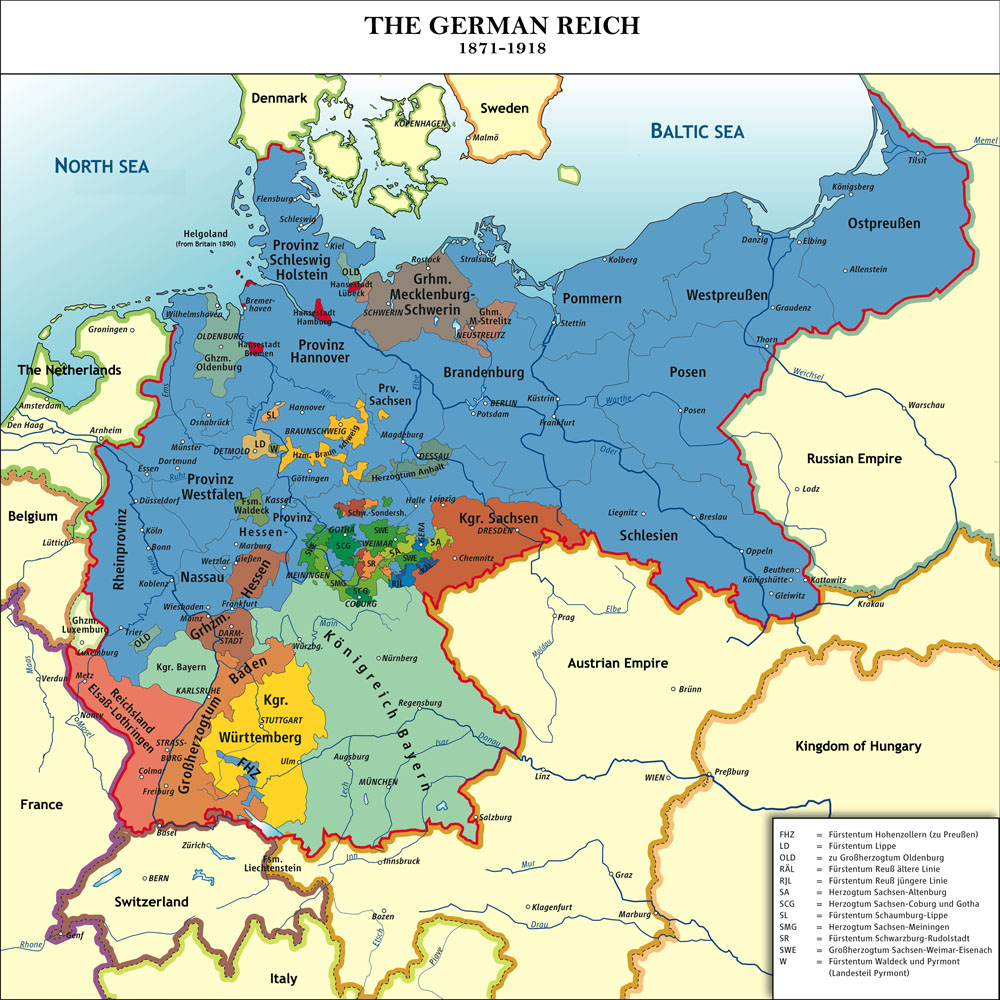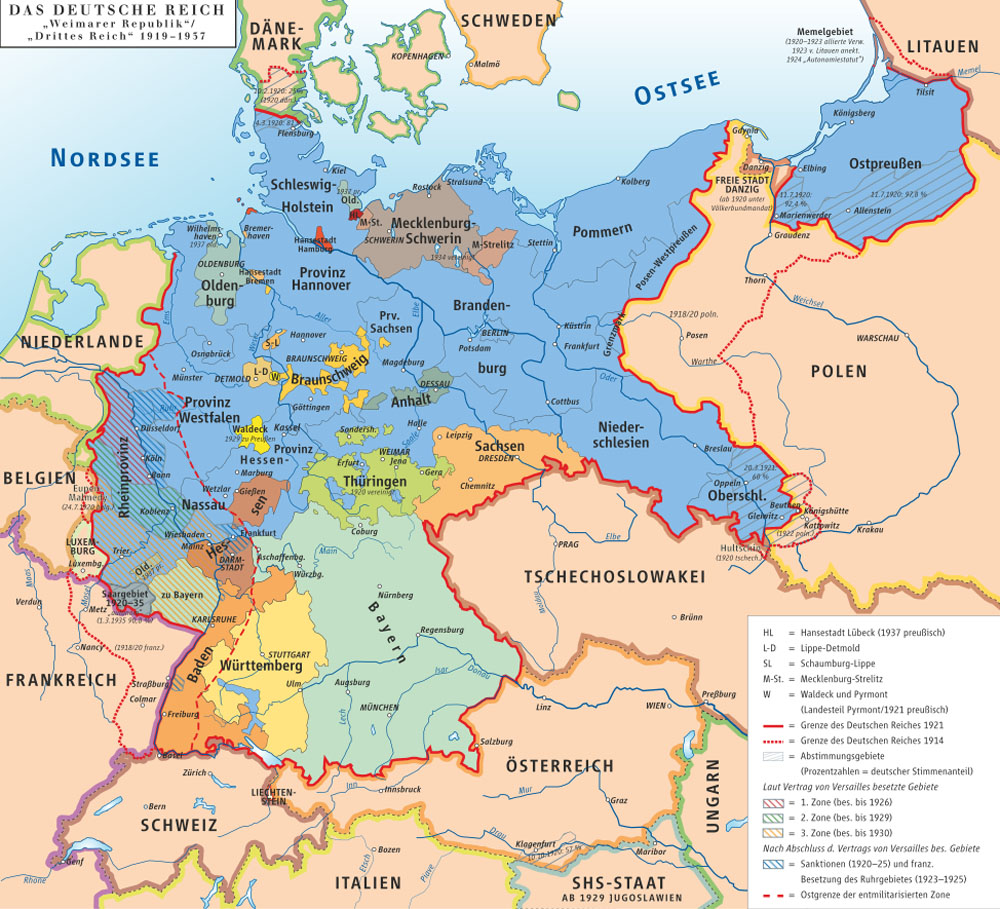
Germany
The emergence of Germany as a nation state, and creation of a Navy
1871 – the German states merged to form one nation-state, ruled by Kaiser Wilhelm I.

1888 Wilhelm I was succeeded (after the 99-day rule of Friedrich III) by Wilhelm II. He had ambitions for Germany on the world stage. He wanted an overseas empire, and for that he needed a navy.
1897 To build a fleet, Wilhelm turned to Admiral Alfred von Tirpitz, who was appointed Secretary of State to the Imperial Naval Office.
Tirpitz identified Great Britain as the main barrier to the Kaiser’s ambitions. He anticipated that, in the event of war, the Royal Navy would blockade Germany’s naval bases in the North Sea. For more than 100 years, the Royal Navy had been the largest in the world, it was larger than the next two navies combined, and was determined to maintain that position.
Tirpitz’s strategy to tackle the Royal Navy was called the Risk Theory. Because Britain used its Navy to safeguard its empire as well as home waters, it could not be strong everywhere. Germany needed to build a navy large enough to force Britain to concentrate its squadrons in its home waters, and also to form an alliance with one or more naval powers. The Royal Navy could then not risk a battle with the German Navy, because if they lost that battle, their weakened Navy would no longer be able to protect the empire, against the strength of two opposing navies.
Britain observed the potential threat from a new naval power in the North Sea with more than a little interest.
In 1903 a series of new navy bases was announced to defend Britain’s east coast, from Scapa Flow in Orkney to Harwich. The existing Royal Navy bases were arrayed along the English Channel from Plymouth to the Thames, because the traditional enemy fleet had come from France and Spain.
In 1904 Jackie Fisher became First Sea Lord of the British Admiralty. He overhauled the fleet and introduced the battleship HMS Dreadnought. Her combination of speed, guns and armour made all previous battleships obsolete. By using standardized components she was able to be completed in a year and a day.
Navies around the world all wanted dreadnoughts – the US, Japan, Italy Turkey, Brazil, Chile, Russia and of course Germany, who realised that if a dreadnought could be built in a year, they had a chance to reach Tirpitz’s goal of a navy 60% of the size of the Royal Navy.
The Royal Navy pressed on with maintaining a 2:1 advantage over any other navy – we had coal, steel and money from the empire.
1912 – the Royal Flying Corps was established, with a Military and a Naval Wing. The Government announced the creation of a series of Air Stations, associated with the new east Coast Naval bases. The first naval air station in Scotland was at Port Laing, just along from the old Submarine Mining Station.
28th July 1914 – World War broke out.
Germany now had a chance to put Tirpitz’s risk strategy to the test. He had created a powerful, modern High Seas Fleet based in Wilhemshaven, and a fleet of U-boats. (But not as big as the Royal Navy.)
The Royal Navy matched the High Seas Fleet by assembling the Grand Fleet – battleships under Admiral Jellicoe, and Battle Cruisers under Admiral Beatty. The fleet was initially based at Scapa Flow. Later the cruisers would move to Invergordon in the Cromarty Firth, then to Rosyth. In 1918 the entire Grand Fleet was based in Rosyth.
The Royal Navy set about its traditional mission and set up a blockade to limit supplies of food, fuel and fertilizer. While this had been anticipated, Germany expected that the war would be over by Christmas, so food shortages and rationing would be merely a nuisance. As the war dragged on, they were saved from starvation by a German chemist – Franz Haber – who invented the process for synthesizing ammonia, which could be turned into nitrate fertilizer. Until then Germany had been dependent on Guano imported from Chile.
It was off the coast of Chile in November 1914 that the first naval engagement took place between Britain and Germany, the Battle of Coronel. Germany won this round but the Royal Navy took revenge at the Battle of the Falkland Islands in December 1914.
The second engagements were at the Dardanelles, where the ill-fated campaign ran from February 1915 to January 1916.
North Queensferry lost one sailor at Coronel, and one at the Dardanelles. Two other died of “Spanish Flu” which affected about one third of the world’s population in 1918 and killed possibly 100 million. (It didn’t come from Spain, but details were censored in the US, UK, France and Germany to maintain morale. The only news came from neutral Spain.)
There were many battles and engagements between elements of the Grand Fleet and the High Seas Fleet in the North Sea. The submarine war largely took place in the Battle of the Atlantic.
Ultimately Tirpitz’s risk strategy failed. The larger Grand Fleet was able to keep the High Seas Fleet more or less confined to its home base all through the war. By the summer of 1918, the impact of the entry of the United States to the war in late 1917, made defeat of the German Army inevitable, and diplomatic efforts ensued to reach a cease fire and a negotiated peace.
By October 1918 armistice conditions were being discussed. These involved a cease fire, immediate cessation of submarine warfare, and the surrender of the most modern elements of the High Seas Fleet to a neutral power.
The German Navy were not happy with these demands. They recalled their submarines, with the intention of having one more pitched battle with the Grand Fleet. The order to put to sea was issued on 27th of October 1918. But many of the sailors did not turn up for duty, went on strike or mutinied. They felt that they were being sacrificed to sabotage the Armistice terms. The attempt was called off on 29th of October.
The Armistice was finally signed on Monday 11th November 1918, coming into effect at 11.00 that day (Paris time.) The dominant feeling was of silence and emptiness after almost 52 months of fighting.
One of the conditions of the armistice was that Germany should hand over the most modern elements of her surface and submarine fleets. This took place in the Surrender in the Forth November 1918.
Immediately after the surrender, the German ships were inspected to verify that they had been completely disarmed, and arrangements were at once made for sending them on to Scapa Flow.
The armistice signed on 11th November 1918 was renewed on 13th December 1918, then again on 16th January 1919 and again on 16th February 1919 as peace negotiations dragged on.
In Scapa Flow, von Reuter and his staff were still unhappy about the surrender of their fleet and there was no conclusion from the peace talks about how the German ships should be shared out among the Allies. On 17th of June 1919, von Reuter ordered his captains to scuttle their ships.
For the last time Imperial War flags were raise to the mastheads as scuttles and valves were opened to let seawater rush in. By the end of the day, 51 ships were sent to the bottom of Scapa Flow.
Privately, many of the British realized that von Reuter had done them a favour. The scuttling had immediately ended the squabbling over the division of the ships, and this speeded up the process of treaty negotiations.
When the Germans were finally released in January 1920, they were hailed as heroes upon their return to Germany.
Peace was finally settled by the Treaty of Versailles which was signed one week later on 28th June 1919 and took effect on 10th January 1920.

Germany lost territory to France, Denmark, Poland and Austria. The Rhineland was occupied by Allied forces. Germany had to disband her army and navy, and pay what many felt were punitive damages and costs to the Allied powers.
Resentment simmered beneath the surface and erupted in the 1930s.